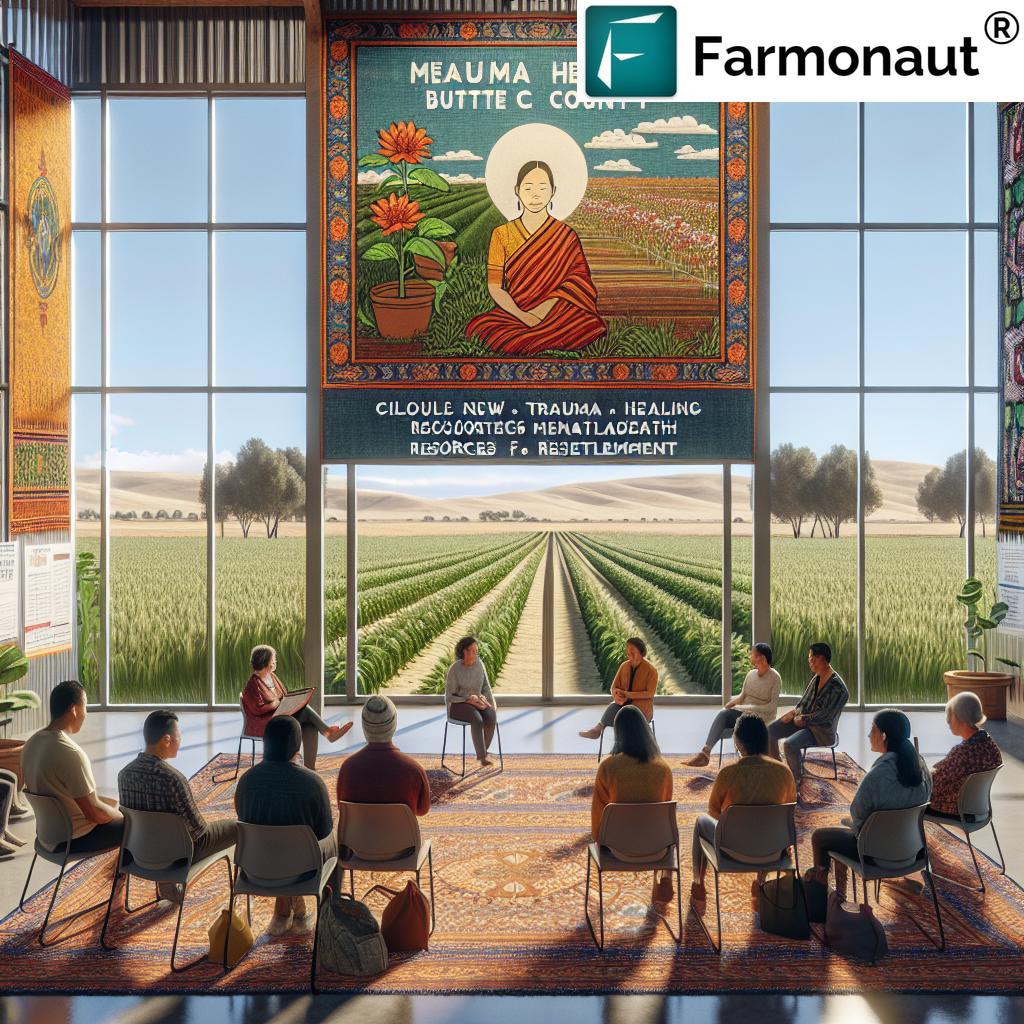Hmong Resilience in Butte County: Preserving Culture and Healing Trauma in Chico’s Growing Asian Community
“Chico’s Hmong population has grown significantly since the Vietnam War, with many refugees resettling in Butte County, California.”
In the heart of Northern California’s Butte County, a remarkable story of resilience, cultural preservation, and community building unfolds. The Hmong community, with its rich heritage and complex history, has become an integral part of the region’s social fabric. Today, we delve into the journey of the Hmong people in Butte County, exploring their struggles, triumphs, and ongoing efforts to maintain their cultural identity while healing from the traumas of war and displacement.
The Hmong Journey to America: A Tale of Courage and Resilience
The story of the Hmong community in Butte County begins with the tumultuous events of the Vietnam War. During this conflict, the CIA enlisted Hmong men and boys to fight for the United States in what became known as the “Secret War” in Laos. Following the U.S. withdrawal of its last troops, the Hmong faced a dire struggle for survival against communist regimes, resulting in mass displacement, a refugee crisis, and ultimately, immigration to various countries, including the United States.
This mass exodus marked the beginning of a new chapter for many Hmong families, who found themselves navigating unfamiliar territories and cultures. The resettlement process in the United States presented numerous challenges, from language barriers to cultural differences. However, it was in places like Butte County that many Hmong refugees found a glimmer of hope and the opportunity to rebuild their lives.

Establishing Roots in Butte County
According to Ge Yang, Program Manager at the Hmong Cultural Center of Butte County, the first Hmong family settled in the area during the early 1980s. What drew them to this particular region? The answer lies in the striking similarities between Butte County’s geography and the Hmong homeland, coupled with promising agricultural opportunities that resonated with their traditional farming practices.
The familiar landscape and agricultural potential of Butte County provided a sense of comfort and opportunity for the newly arrived Hmong families. This connection to the land has played a crucial role in the community’s ability to maintain aspects of their cultural heritage while adapting to life in America.
Growth and Challenges: The Hmong Community Today
Fast forward to the present day, and we see a thriving Hmong community that has significantly impacted the demographic landscape of Butte County. At Chico State, Hmong students now comprise the largest Asian sub-group, reflecting the growing presence and contributions of the community to the Northstate region.
However, challenges persist. Census data suggests that there are approximately 4,800 Hmong individuals in Butte County. Yet, community leaders suspect this number to be significantly higher due to underreporting. Ge Yang explains, “There has been a lot of census disparities within the Hmong-Asian community here. Being with the Hmong cultural center for the past 10 years, I know that on average, we serve over 4,000 already and there are those that are not counted for.”
This underreporting in immigrant communities can have serious implications, potentially impacting resource allocation and representation for Hmong communities in Northern California. It underscores the need for continued efforts to engage and accurately represent the Hmong population in official statistics.
Preserving Hmong Culture in America: A Delicate Balance
One of the most significant challenges faced by the Hmong community in Butte County is the preservation of their unique cultural heritage. As younger generations grow up in American society, there’s a risk of losing touch with traditional Hmong customs, language, and practices.
To address this concern, various initiatives have been established to promote and preserve Hmong culture. The Hmong Cultural Center of Butte County plays a pivotal role in these efforts, organizing events, workshops, and programs that celebrate Hmong heritage and foster intergenerational connections.
These cultural preservation efforts are not just about maintaining traditions; they’re about building resilience and fostering a sense of identity among Hmong-Americans. By connecting with their roots, many in the community find strength and pride in their heritage, which can be a powerful tool in navigating the complexities of life in America.
Addressing Refugee Trauma and Mental Health
The journey from war-torn Laos to the United States has left deep scars on many in the Hmong community. The trauma of war, displacement, and the challenges of resettlement have had lasting impacts on mental health across generations.
Cindy Vang, an Assistant Professor at the School of Social Work at Chico State, highlights this issue: “Because of the war, the resettlement, and then resettlement in an environment that has historically, I think, and currently has been challenging for immigrants and refugees here in the United States, I think there’s a lot of trauma.”
Recognizing the importance of addressing these mental health challenges, there’s a growing focus on mental health and resilience for refugees within the Hmong community. Mental health professionals are working to understand the specific traumas experienced by Hmong individuals and developing culturally sensitive approaches to healing.
The Role of Community Centers and Events
Community centers and cultural events play a crucial role in fostering social connections and promoting healing within the Hmong community. The Hmong Cultural Center of Butte County, for instance, serves as a hub for various activities and programs designed to support community members of all ages.
These centers often host Hmong cultural center events that celebrate traditional holidays, showcase Hmong art and crafts, and provide opportunities for community members to come together. Such gatherings not only help preserve cultural practices but also create spaces for intergenerational dialogue and support.
Recently, the Hmong community at Chico State, in collaboration with the broader Butte County Hmong population, organized a special event focused on mental health and resilience. This gathering exemplifies the community’s commitment to addressing challenging topics while celebrating their shared heritage.
Agricultural Heritage and Modern Farming
The Hmong community’s strong agricultural heritage has played a significant role in their resettlement and integration in Butte County. Many Hmong families have leveraged their traditional farming knowledge to establish successful agricultural enterprises in the region.
This connection to agriculture not only provides economic opportunities but also serves as a link to cultural practices and values. Farming remains an important aspect of Hmong identity, even as younger generations pursue diverse career paths.
In recent years, there has been growing interest in combining traditional Hmong farming techniques with modern agricultural technologies. This blend of old and new approaches has the potential to create more sustainable and efficient farming practices, benefiting both the Hmong community and the broader agricultural sector in Butte County.
For those interested in modern agricultural technologies, Farmonaut’s crop plantation and forest advisory services offer valuable insights for farmers looking to optimize their operations using satellite data and AI-driven recommendations.

Education and Empowerment
Education has emerged as a powerful tool for empowerment within the Hmong community of Butte County. As more Hmong students pursue higher education, they’re not only creating better opportunities for themselves but also serving as role models for younger generations.
Chico State University has played a significant role in this educational journey. The growing presence of Hmong students on campus has led to the development of Hmong language courses, cultural programs, and student organizations that cater to the unique needs and interests of Hmong-American students.
These educational initiatives extend beyond the university setting. Community-based programs offer language classes, cultural workshops, and mentorship opportunities, ensuring that Hmong youth have access to resources that support both their academic and cultural growth.
Bridging Generations: The Challenge of Cultural Continuity
One of the most pressing challenges facing the Hmong community in Butte County is the generational gap between those who experienced life in Laos and the younger generations born and raised in the United States. This divide can sometimes lead to misunderstandings and conflicts within families and the broader community.
Community leaders and educators are working tirelessly to bridge this gap, creating opportunities for dialogue and understanding between generations. Programs that bring together elders and youth to share stories, skills, and experiences are helping to foster a sense of continuity and mutual respect.
As Cindy Vang notes, “We’re hoping that these conversations that are started today can continue beyond the event today and that families have deeper conversations about what it means to be Hmong, what can we preserve, moving into the future.”
The Impact of Census Underreporting
“Census underreporting affects Asian populations, potentially impacting resource allocation and representation for Hmong communities in Northern California.”
The issue of census underreporting among the Hmong and other Asian populations in Butte County is a significant concern. Accurate census data is crucial for ensuring proper resource allocation, political representation, and the development of community-specific programs.
Several factors contribute to this underreporting, including:
- Language barriers
- Mistrust of government institutions
- Lack of awareness about the importance of census participation
- Fear among undocumented individuals
Community organizations and local government agencies are working to address these challenges through targeted outreach programs, multilingual census materials, and education campaigns. These efforts aim to ensure that future censuses more accurately reflect the true size and diversity of the Hmong community in Butte County.
Economic Contributions and Entrepreneurship
The Hmong community has made significant economic contributions to Butte County through various entrepreneurial ventures. From small family-owned businesses to larger agricultural operations, Hmong-Americans have demonstrated remarkable resilience and innovation in the face of economic challenges.
Many Hmong entrepreneurs have found success in sectors such as:
- Agriculture and farming
- Retail and restaurants
- Professional services
- Cultural goods and crafts
These businesses not only provide economic opportunities for Hmong families but also contribute to the overall economic diversity and vitality of Butte County. Supporting these enterprises is crucial for the continued growth and success of the Hmong community in the region.
Healthcare Access and Cultural Competency
Access to culturally competent healthcare remains a challenge for many in the Hmong community. Language barriers, cultural differences in understanding health and illness, and a lack of Hmong healthcare providers can all contribute to disparities in health outcomes.
Efforts are underway to address these issues through:
- Training programs for healthcare providers on Hmong cultural practices and beliefs
- Recruitment of Hmong individuals into healthcare professions
- Development of culturally appropriate health education materials
- Collaboration between Western medical practitioners and traditional Hmong healers
These initiatives aim to improve health outcomes and build trust between the Hmong community and healthcare institutions in Butte County.
Political Representation and Civic Engagement
As the Hmong community in Butte County continues to grow, there’s an increasing focus on political representation and civic engagement. While progress has been made, there’s still work to be done to ensure that Hmong voices are heard in local government and decision-making processes.
Community leaders are working to:
- Encourage voter registration and participation
- Develop leadership programs for young Hmong-Americans
- Advocate for policies that address the specific needs of the Hmong community
- Foster partnerships with other community organizations and local government agencies
These efforts are crucial for building a more inclusive and representative political landscape in Butte County.
The Future of the Hmong Community in Butte County
As we look to the future, the Hmong community in Butte County stands at a crossroads of opportunity and challenge. The resilience that has defined their journey thus far continues to be a driving force in shaping their path forward.
Key areas of focus for the future include:
- Continued efforts in cultural preservation and intergenerational understanding
- Expansion of educational and economic opportunities
- Addressing ongoing mental health and trauma-related issues
- Increasing political representation and civic engagement
- Fostering partnerships with other communities and institutions
The story of the Hmong in Butte County is far from over. It’s a living narrative of resilience, cultural pride, and community building that continues to unfold with each passing year.
Hmong Population Growth and Community Milestones in Butte County
| Year | Estimated Hmong Population | Key Community Events | Cultural Preservation Initiatives |
|---|---|---|---|
| 1980s | ~100 | First Hmong family settles in Butte County | Informal gatherings to maintain traditions |
| 1990s | ~1,000 | Establishment of first Hmong grocery store | Formation of Hmong language classes |
| 2000s | ~2,500 | Opening of Hmong Cultural Center of Butte County | Annual Hmong New Year celebration begins |
| 2010s | ~4,000 | First Hmong-American elected to local office | Launch of Hmong cultural preservation program at Chico State |
| Present | ~4,800+ | Mental health and resilience focused community event | Intergenerational storytelling project |
Conclusion: A Testament to Resilience and Community
The story of the Hmong community in Butte County is a powerful testament to the resilience of the human spirit and the strength found in cultural identity. From the challenging days of resettlement to the vibrant community we see today, the Hmong people have overcome numerous obstacles while preserving their rich heritage.
As we continue to support and celebrate the Hmong community in Butte County, it’s crucial to recognize the ongoing challenges they face, from addressing historical trauma to ensuring accurate representation in census data. By fostering understanding, promoting cultural preservation, and supporting community initiatives, we can help ensure that the Hmong community continues to thrive and contribute to the rich tapestry of life in Northern California.
The journey of the Hmong in Butte County serves as an inspiration not only to other immigrant communities but to all who value resilience, cultural diversity, and the power of community. As Cindy Vang beautifully summarized, “50 years later, Hmong people are still here existing, surviving, some may describe their situation as thriving.” It’s a journey that continues, with each generation adding its own chapter to this remarkable story of resilience and hope.
FAQ Section
Q: When did the first Hmong families arrive in Butte County?
A: According to community leaders, the first Hmong family settled in Butte County during the early 1980s.
Q: What drew Hmong refugees to Butte County?
A: Hmong refugees were drawn to Butte County due to its similar geography to their homeland and promising agricultural opportunities.
Q: How large is the Hmong population in Butte County today?
A: While census data suggests around 4,800 Hmong individuals, community leaders believe the actual number is higher due to underreporting.
Q: What challenges does the Hmong community face in preserving their culture?
A: Key challenges include language preservation, maintaining traditional practices, and bridging the gap between older and younger generations.
Q: How is the community addressing mental health issues related to refugee trauma?
A: The community is focusing on culturally sensitive mental health services, community events, and programs that promote healing and resilience.
Q: What role does agriculture play in the Hmong community in Butte County?
A: Agriculture remains an important part of Hmong identity and economic activity, with many families operating farms and agricultural businesses.
Q: How can the broader community support Hmong cultural preservation efforts?
A: Supporting Hmong-owned businesses, attending cultural events, and advocating for inclusive policies are ways to support the Hmong community.
Resources for Further Information
For those interested in learning more about the Hmong community in Butte County or seeking support services, the following resources may be helpful:
- Hmong Cultural Center of Butte County: [Website link]
- Chico State University Hmong Student Association: [Website link]
- Butte County Office of Refugee Services: [Website link]
- California Hmong Farmers Association: [Website link]
By continuing to support and celebrate the Hmong community, we ensure that their rich culture and valuable contributions remain an integral part of Butte County’s diverse tapestry for generations to come.
Earn With Farmonaut: Affiliate Program
Earn 20% recurring commission with Farmonaut’s affiliate program by sharing your promo code and helping farmers save 10%. Onboard 10 Elite farmers monthly to earn a minimum of $148,000 annually—start now and grow your income!
















